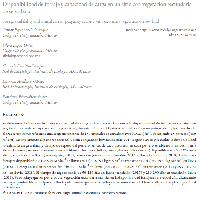Resumen
-
Se determinó la biomasa forrajera y capacidad de carga instantánea en función a la disponibilidad de forraje en un sitio con vegetación secundaria bajo pastoreo regenerativo, durante 12 meses. El estudio se estableció en un potrero de 0.5 ha, para dividir el área se usó como referencia una carga instantánea de 157 unidades de ganado mayor (UGM) ha-1, obteniendo 15 potreros (500 m2 c/u). Se implementó el pastoreo racional Voisin con ganado bovino, de julio 2017 a agosto 2018 y se evaluó la disponibilidad forrajera, la carga animal y tiempo de reposo del potrero. Antes de cada pastoreo, en cada potrero se ubicaron marcos (1 m2) aleatoriamente y se cosechó manualmente la biomasa forrajera (follaje, frutos, flores y tallos tiernos) disponible entre 0 y 170 cm de altura, en la época de lluvia (julio-agosto, 2017), transición (noviembre-diciembre, 2017) y lluvia (junio-julio, 2018). La biomasa
forrajera disponible fue 2,196.9 kg MS ha-1 en lluvia (2017); 1,815.4 kg MS ha-1 en transición (2017) y 2,297.7 kg MS ha-1 en lluvia (2018). La carga animal instantánea fue 146.4 UGM ha-1 en lluvia (2017); 121.4 UGM ha-1 en transición (2017) y 153.1 UGM ha-1 en lluvia (2018). El tiempo de reposo osciló de 50-120 días en lluvia-transición (2017) y 210-290 días en transición-lluvia (2018). Se concluye que los potreros con vegetación secundaria mantienen la disponibilidad forrajera a través del año, alcanzando su mayor producción en la época de lluvia y el manejo regenerativo influye en el aumento de la biomasa disponible y la carga animal instantánea. - The forage biomass and instant animal carrying capacity depending on the availability of forage in a site with secondary vegetation under regenerative grazing for 12 months were determined. The study was established in a pasture plots of 0.5 ha, to divide the area an instant load of 157 animal units (AU) was used as reference on a ha-1, obtaining 15 paddocks (500 m2 each). Voisin rational grazing with cattle, from July 2017 to August 2018 August was implemented and assessed forage availability, carrying capacity and the paddock rest time. Before each grazing, in each pasture frameworks (1 m2) were settled randomly and the forage biomass (foliage, fruits, flowers and tender stems) available between 0 and 170 cm in height, was harvested manually in different seasons: rain (July-August, 2017), transition (November-December, 2017) and rain (June-July,2018). The available forage biomass was 2196.9kg DM ha-1 in rain (2017); 1815.4 kg DM ha-1 in transition (2017) and 2297.7 kg DM ha-1 in rain (2018). The instant carrying capacity was 146.4 AU ha-1 in rain (2017); 121.4 ha-1 AU in transition (2017) and 153.1 UGM ha-1 in rain (2018). The standing time ranged from 50-120 days in rain-transition (2017) and 210-290 days in transition-rain (2018). It is concluded, the paddocks with secondary vegetation maintain forage availability throughout the year, reaching its highest production during the rainy season and regenerative management influences the increased biomass available and instant animal carrying capacity.
